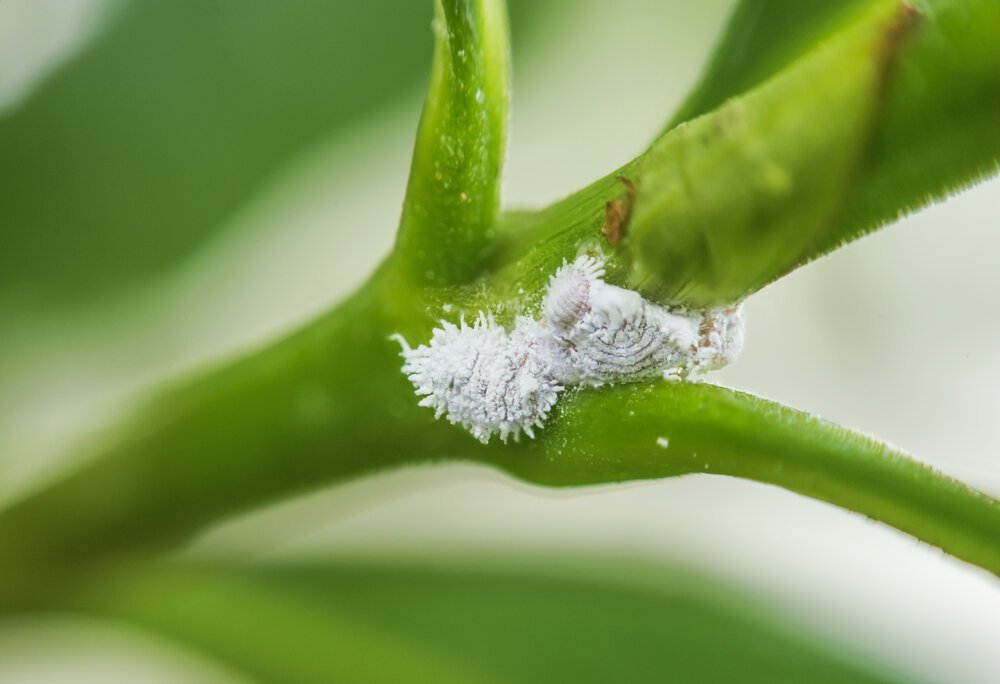4 most common home office plant pests and how to treat them
Indoor greenery is the perfect way to upgrade your home office setup. Bringing a touch of nature into your home can help with focus, reduce stress, and improve air quality – as well as looking beautiful. But you can get more than you bargained for when you buy a new houseplant.
Nobody wants bugs crawling all over their keyboard. Luckily there are ways to avoid getting insects on plants. And if you do end up with uninvited guests, it’s easy to control and treat plant pests before they become a problem.
There isn’t much more annoying than a room full of insects while you’re trying to work.
Avoiding plant bugs
Before we get into treating pests, here are some tips for how to avoid them in the first place. When buying plants, choose those with healthy foliage and make sure there aren’t any visible insects. Check where the leaves join the stem, and remember to look for eggs or webbing across the soil.
Once you bring your new plant home, keep it quarantined for two weeks and inspect the soil and leaves every few days for signs of pests. This protects your other plants from infection if bugs do appear. Use fresh substrate to repot plants (here’s a handy repotting guide for new plant parents) or sterilize your potting soil before use to kill mold spores and insect eggs.
Give your greenery the right growing conditions: strong, healthy plants find it easier to fight an infestation. Clear dead leaves from the soil surface and regularly wipe leaves with a damp cloth to keep them clean. And avoid overwatering – damp soil is the ideal breeding ground for some pests.
When your new plant arrives, always keep it away from others for 2 weeks.
Identifying and treating common pests
Usually these measures are enough to keep your plants happy and pest-free. But don’t worry if you find bugs in your workspace – once you’ve got to the root of the problem, pests are easy to treat. Here’s how to identify (and get rid of!) the 4 most common houseplant pests.
1: Fungus Gnats
Fungus gnats are small black flies that live in soil and thrive in damp environments. They lay their eggs in the top few centimeters of potting mix, where the larvae feed off fungus. These flies are harmless to adult plants – but can be annoying if they start buzzing around your desk while you’re in the middle of a call.
Avoid fungus gnats by watering your plants from the bottom, and letting the potting mix dry out completely before you give them another drink. If you already have a problem with gnats, treat the infected plant with a mixture of dish soap and water to kill the larvae. Flypaper or a homemade fly trap (try apple cider vinegar and a couple of drops of dish soap) will take care of the adults.
Sticky flypaper is one of the best ways to get rid of fungus gnats.
2: Spider mites
Cobwebs on your houseplants? Then you’ve probably got spider mites – tiny creatures that feed on leaves and are difficult to spot. They prefer dry conditions, so will be attracted to houseplants that need less water. Yellow or brown specks will appear on the foliage where they’ve been feeding, and you might see yellowing around the edges of leaves too.
To get rid of spider mites, hose down the leaves in a sink or the shower. This should dislodge most of the bugs. Afterwards, treat the infected plant with neem oil (you can buy a spray or mix the oil with water yourself) to finish off these pests. Use neem once a week until you’re sure the mites are gone.
Webs might be easier to spot than the spider mites themselves.
3: Mealybugs
These white fluffy bugs cluster together where the leaves of your houseplants join the stems. Mealy bugs feed on sap, causing leaves to yellow and droop – and you might find a sticky residue known as honeydew on or around the infected plant. But you’ll see the insects themselves before they have the chance to damage your greenery.
Use a damp cloth to wipe these bugs off delicate leaves. More robust plants can have a shower to remove the mealybugs. After physically removing these insects, treat your plant with neem oil to stop them from coming back.
Luckily mealy bugs are easy to spot, liking to gather at the joints of stems.
4: Thrips
Thrips are slender black insects that live on the plant itself and in the potting soil – depending on the stage in their lifecycle. These bugs lay their eggs on leaves, and the adults can fly. Dry silvery spots will appear on your plant where thrips have been sucking sap from the leaves.
As with fungus gnats, you can use fly traps to catch the adults. Or (for a completely natural solution) you could try placing fly-eating plants such as a venus fly trap near the infected plant. Wash the leaves to get rid of any remaining eggs, and treat the plant with neem oil.
A clear sign of a thrips problem is silvery spots appearing on leaves.
Don’t let plant pests put you off growing your collection of home office greenery. With this simple guide, any unwanted insects are easy to get rid of.
Plantclub.io provides you and your colleagues with the benefits of plants, wherever you work. Rent office plants and transform your space into a green oasis, with flexible monthly membership options to suit your size. Diversify your employee perks with a dedicated company store, where you can give green gifts and your team can buy plants for their home office. Book a time to chat with us today.







